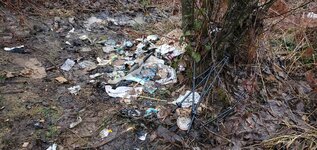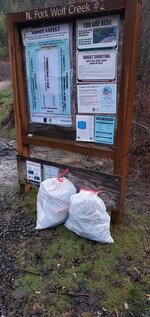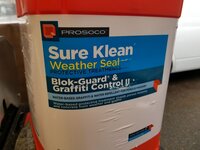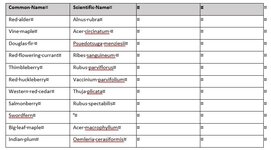Gold Supporter
- Messages
- 5,251
- Reactions
- 13,385
And... We have another $50! Thank you Patrick! We're up to $490 now!
Follow along with the video below to see how to install our site as a web app on your home screen.
Note: This feature may not be available in some browsers.
Thank you Patrick !!!!!!!!!!!!!!!!!!!!!!!!!!!!!!!!!!!!!!!!!!!!!And... We have another $50! Thank you Patrick! We're up to $490 now!






Thanks Michael!Donated $50. I like shooting here, even if I wind up on nearby public lands at least 1/2 the time.
Regarding the Public Safety Project at Wolf Creek lane 3...
Wow! I'm learning a lot about this planting stuff! Things I never wanted to know, like Vaccinium Parvifolium, Rubus Spectabilis and Alnus Rubra! (Red Huckleberry, Salmonberry and Red Alder) and more.
My native landscape guy and I are laying out the planting plan. Different species need different distances apart and there's the water issue… A good tip he has is to add wood chips around the plant. They help retain moisture and will help new seedlings to take hold around the plant.
If we plant in April, we're going into a hot dry summer season and they will need water to survive! So, we're trying to plan for hearty plants at first (that may survive the summer), and do a second planting in the fall.
We may need to break this project into two separate events because of the potential for dead plants from the summer heat with no water. For the first go round, we like to accomplish:
That's the majority of the project. The second phase won't cost as much and we won't need to rent excavating equipment. We would then finish planting the void spots.
- Ground disturbance. Rough up the ground and smooth out the 'backstop'. Make it not so easy to walk on.
- Plant the backstop.
- Plant across the front access and the back edge.
- Get a few plants in the middle.
- Rope off whole area with caution tape and maintain as needed.
I found a supplier of native plants who is based out of Forest Grove! Scholls Valley Native Nursery. I love their website! Very informative. Karl, the owner, is very responsive to my questions and very helpful. I have a good feeling that he may be a great outfit to work with. He may also be the only native nursery in all of the Portland Metro area.
Schedule… If we can raise the funds soon enough, I'd like to get plants in the ground in early April. I hate for projects to go on too long! We'll need to ramp up our fundraising efforts and try to come up with as much as we can, as soon as we can. We'll see how much we can get done in April, and then plan on the rest by fall.
Oh, the excavator cost is looking to be about a $400 bill (with a 1 day rental, trailer rental and fuel). Most likely, I'll rent one from NW Equipment Rental in Hillsboro. We will need someone with a 3/4 ton pickup to haul it. Pick up on a Friday evening, and return it by Sat 5 PM.
So that's what I got for now. Any thoughts or input?
Bill
WOOT !!!!!!!!!!!!!!!!!!!!!!! Many thanks Micheal !!!!!!!!!!!!!!!!!!!!!!!!!!!!!!!!!!!!!!!!!!!!!!!!!Donated $50. I like shooting here, even if I wind up on nearby public lands at least 1/2 the time.
You got that right, Mike. Finally, someone gave the whole situation some serious consideration! The time of year for this project is not good to plant. It is certainly direct sunshine all day long and very little rain. We're considering some options.I'd like to ask what kind of money you're looking to spend to buy and install these "Native" plants? You have to realize that the forest is actually not fertile ground. It isn't historic flood plain like the Willamette Valley. The coast range is very inhospitable to many plants. Think about billions of seeds, and really, only a few survive. Think about where you're expecting these plants to grow, on that landing. It's basically a highly compacted gravel with very little native soil. Unless you're going to dig holes for your plants that are, at least, 2-times the diameter of the pot, (three times would be better), and use a fertile planting mix in the planting hole, those new plants are going to have a rough time of it. Especially considering you're looking to get them in the ground, mid April(?) That's only two months until mid June when the sun will be beating down on that landing. Keeping those plants watered through hot sunny weather will be absolutely necessary. Even with good added soil in the planting holes. Just something to consider. Making the area so people won't shoot from there seems to be the priority. Planting stuff might be better to do in late September/early October.
Much about this project is unprecedented, and we've considered the issue of water during the hot summer months and currently we're considering a phased planting schedule with at least half of the plants being planted in late summer/early fall. Fortunately Bill has access to a well informed landscaper who's helping us with this project. I personally have no issues with filling up the back of my Outback with gallon jugs filled with water and going up there at least once a week to water them. With the number of volunteers stepping up, I think we stand a good chance of keeping what we plant alive and healthy.I'd like to ask what kind of money you're looking to spend to buy and install these "Native" plants? You have to realize that the forest is actually not fertile ground. It isn't historic flood plain like the Willamette Valley. The coast range is very inhospitable to many plants. Think about billions of seeds, and really, only a few survive. Think about where you're expecting these plants to grow, on that landing. It's basically a highly compacted gravel with very little native soil. Unless you're going to dig holes for your plants that are, at least, 2-times the diameter of the pot, (three times would be better), and use a fertile planting mix in the planting hole, those new plants are going to have a rough time of it. Especially considering you're looking to get them in the ground, mid April(?) That's only two months until mid June when the sun will be beating down on that landing. Keeping those plants watered through hot sunny weather will be absolutely necessary. Even with good added soil in the planting holes. Just something to consider. Making the area so people won't shoot from there seems to be the priority. Planting stuff might be better to do in late September/early October.
I have also been thinking about the big container you can rent, fill it with water and have a long hose that would reach the plants. Have someone with a truck go up every so often and water. That would be an 'Ify' kind of plan and I'm not so sure it would work consistently.Much about this project is unprecedented, and we've considered the issue of water during the hot summer months and currently we're considering a phased planting schedule with at least half of the plants being planted in late summer/early fall. Fortunately Bill has access to a well informed landscaper who's helping us with this project. I personally have no issues with filling up the back of my Outback with gallon jugs filled with water and going up there at least once a week to water them. With the number of volunteers stepping up, I think we stand a good chance of keeping what we plant alive and healthy.
Absolutely right, Mike. Here's a list of ODF approved native species that we may plant in that area. You would find any of these all over the McGregor Basin area. We are planning on 4, maybe 5 of these and several of each kind, depending on if they are trees or shrubs and in variable sizes.Just consider this....what grows there now? What ever you plant, without an oversized planting hole with decent soil and something that actually holds water long enough to give the new plant a good start. Well, same question what grows there now? That would be the criteria to use.

Not to derail from the AMAZING project-oriented conversation going on here (seriously, this is the coolest thing on the board, y'all)... BUT!
Anybody been using the lanes lately? Are they available? I've got a new rifle for the Fall season needs sighting in and was hoping to head over to North Fork one of the next couple weekends.
I was up there last week and while there was still signs of snowfall on the sides of the road, both Wolf Creek Rd and the road to lanes are back to fully accessible. The lanes are open as always, and busy, as always. Get there early or bring something to bide your time while you wait, but either lane 3 or 4 would be excellent for sighting in your rifle.Not to derail from the AMAZING project-oriented conversation going on here (seriously, this is the coolest thing on the board, y'all)... BUT!
Anybody been using the lanes lately? Are they available? I've got a new rifle for the Fall season needs sighting in and was hoping to head over to North Fork one of the next couple weekends.